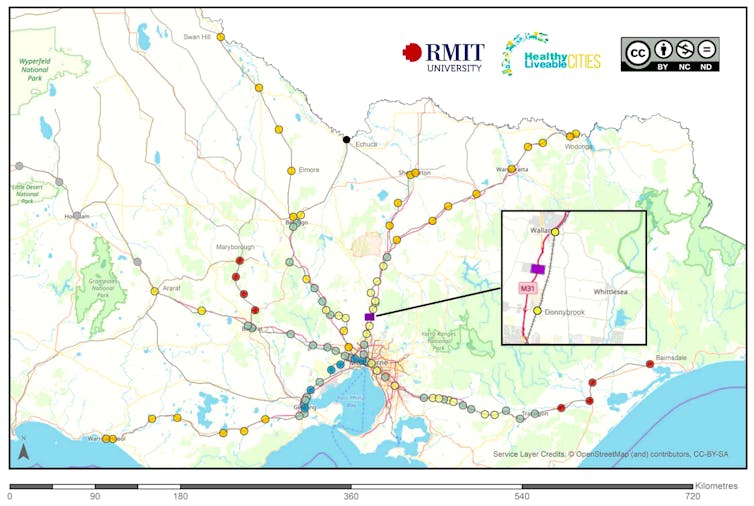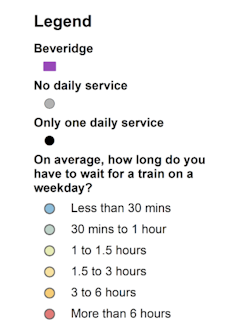Rail access improves liveability, but all regional centres are not equal
- Written by Melanie Davern, Senior Research Fellow, Healthy Liveable Cities Group, Centre for Urban Research, RMIT University
Our research on the liveability of regional cities in Victoria has identified an important element: liveability in these areas requires fast, reliable and frequent rail connections to capital cities.
Previous research has established that we need better models of early transport delivery in growth areas of Melbourne. Public transport, in particular, is an essential ingredient for a liveable community. Less attention has been paid to transport in regional areas, particularly regional areas with growing populations.
Read more: Commuters help regions tap into city-driven growth
People living in regional areas still need access to capital cities. The reasons include employment, education, medical services, shopping, arts, culture and visits to family and friends.
Regional Victorians who lack access to reliable rail services remain deprived of non-car travel options. This forces them to drive and that adds to traffic congestion in our capital cities. Car dependency is costly for health and wealth.
Regional rail is important both to meet the needs arising from predicted population increases across regional areas and to manage the rapid population growth and sprawl of our capital cities. Australia’s population is predicted to increase by 45 million by 2100 and our cities are already expanding rapidly. We need to start thinking about where these extra people are going to live.
At present, most people (more than 80%) in Australia live in capital cities. However, as populations grow, more people will start moving to regional areas. This means we need to pay more attention to the liveability of regional Australia as well as capital cities.
Wherever they live, people need transport to get to employment, education, shops and services, and to socialise with friends, family and community members. Furthermore, our research has found that having close access to a range of these things is associated with better health and well-being. Good access to frequent, reliable and fast transport is not a luxury. It is a critical factor influencing liveability and is described as a social determinant of health – one of the conditions (where we live, learn, work and play) that influence our health.
Read more: Build in good services from day one for healthier communities: lessons from Selandra Rise
Liveable places promote health and well-being among the people who live there. However, they also require transport options, including public transport such as trains, buses, trams as well as walking and cycling. In regional areas expansive distances make it hard to get by without a private vehicle.
A good example of this is Mitchell Shire. It begins at the northern edge of metropolitan Melbourne and extends to the regional town of Seymour in northeastern Victoria.
The population is booming in this non-metropolitan shire. The small town of Beveridge is expecting to accommodate at least 150,000 people in new urban development over the next 30 years. To put that into context, the town had a population of just over 2,300 people in 2016.
To understand the current regional rail services (and liveability) for areas like Beveridge we produced the summary map below.

 Wait times between 6am and 9pm for regional train routes with a daily service on weekdays. Calculated using Public Transit Victoria data from April 12 to June 10, 2018.
Author provided
Developers’ signs in the Beveridge area are advertising “40 minutes to the city” along the Hume Highway. Perhaps they are including a helicopter in their house and land packages. Based on current regional rail options, residents must drive to their nearest station 10-15 minutes away, wait for a train – services depart at intervals of 34-105 minutes – and then travel up to an hour to the city during peak hour.
Alternatively, these developments might be encouraging car use as the main means of transport. In that case, Google Maps suggests peak-hour travel from Beveridge to the Melbourne central business district takes between one and two hours on a weekday. Again, as well as being associated with poor health outcomes, long commutes by car will increase traffic congestion along the route and in the city.
Read more:
This is how regional rail can help ease our big cities' commuter crush
The map above also suggests that some areas of regional Victoria are doing better than others in terms of regional rail connections to Melbourne.
Consider the examples of Bendigo and Shepparton in central and north-eastern Victoria. Shepparton is a large regional centre, with an economy established in health services and agriculture. Its population is projected to grow to 315,000 people by 2046.
Shepparton Council planning is guided by a liveability framework, a 30-year plan and has recently completed a liveability assessment. However, Shepparton’s economic and social development is restricted by only four train services to Melbourne per day compared to Bendigo’s 27 services.
Similarly, Geelong has a projected population increase of 56% to 445,000 people by 2046. However, duplication and electrification of the overcrowded line remains an unfunded long-term project.
Car dependency, transport planning and urban design are critical social determinants of health that also need to be considered in creating liveable, well-connected communities in regional areas. We need to act now if we are to learn from the liveability lessons of our capital cities and avoid repeating the mistakes.
Wait times between 6am and 9pm for regional train routes with a daily service on weekdays. Calculated using Public Transit Victoria data from April 12 to June 10, 2018.
Author provided
Developers’ signs in the Beveridge area are advertising “40 minutes to the city” along the Hume Highway. Perhaps they are including a helicopter in their house and land packages. Based on current regional rail options, residents must drive to their nearest station 10-15 minutes away, wait for a train – services depart at intervals of 34-105 minutes – and then travel up to an hour to the city during peak hour.
Alternatively, these developments might be encouraging car use as the main means of transport. In that case, Google Maps suggests peak-hour travel from Beveridge to the Melbourne central business district takes between one and two hours on a weekday. Again, as well as being associated with poor health outcomes, long commutes by car will increase traffic congestion along the route and in the city.
Read more:
This is how regional rail can help ease our big cities' commuter crush
The map above also suggests that some areas of regional Victoria are doing better than others in terms of regional rail connections to Melbourne.
Consider the examples of Bendigo and Shepparton in central and north-eastern Victoria. Shepparton is a large regional centre, with an economy established in health services and agriculture. Its population is projected to grow to 315,000 people by 2046.
Shepparton Council planning is guided by a liveability framework, a 30-year plan and has recently completed a liveability assessment. However, Shepparton’s economic and social development is restricted by only four train services to Melbourne per day compared to Bendigo’s 27 services.
Similarly, Geelong has a projected population increase of 56% to 445,000 people by 2046. However, duplication and electrification of the overcrowded line remains an unfunded long-term project.
Car dependency, transport planning and urban design are critical social determinants of health that also need to be considered in creating liveable, well-connected communities in regional areas. We need to act now if we are to learn from the liveability lessons of our capital cities and avoid repeating the mistakes.
Authors: Melanie Davern, Senior Research Fellow, Healthy Liveable Cities Group, Centre for Urban Research, RMIT University



















